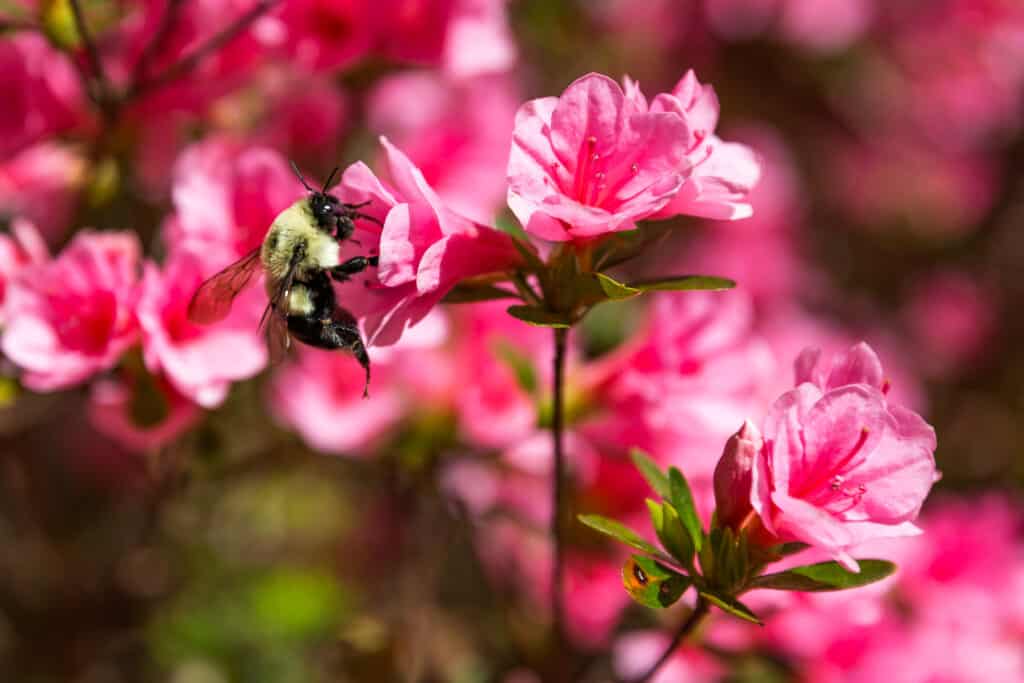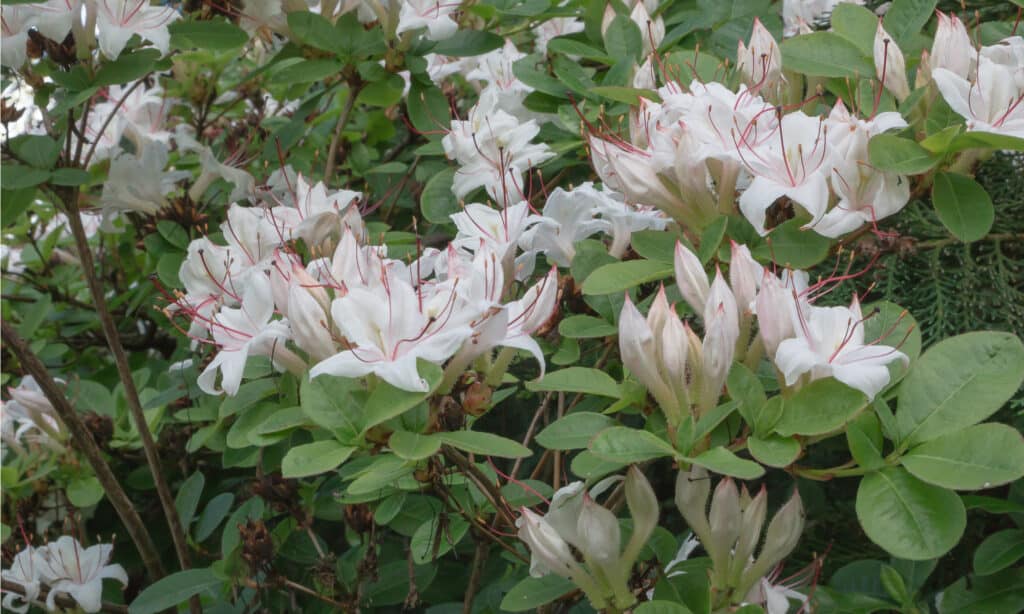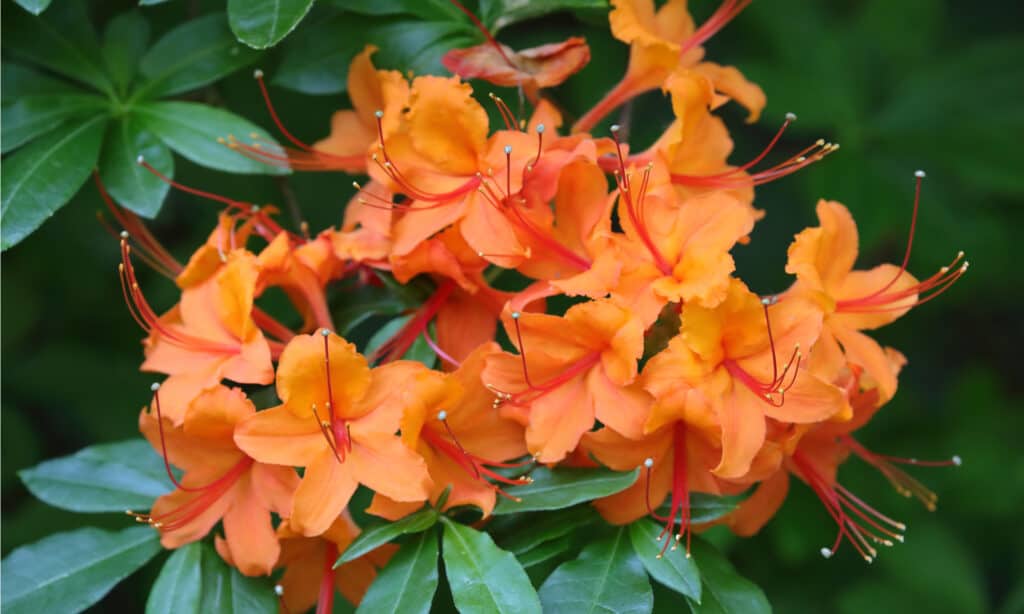Azaleas are part of the Rhododendron family with over 800 species and 10,000 types. They are bushy flowering plants that can transform your garden and home by adding brilliant pops of color in shades like purple, pink, yellow, red, orange, and white. But azaleas get a bad rap for being finicky to grow and maintain, especially in the hot Texas sun. Find out how to grow azaleas in Texas, what types will flourish, and what to plant with these gorgeous bushes.
What Types of Azaleas Can You Grow in Texas?

Kurume, Southern Indica, and Satsuki are some of the best types of azaleas to grow in Texas climates.
©Scott F Smith /Shutterstock.com
Azaleas are diverse plants with several major hybrid groups. These shrubs can be compact or large, with leaves ranging from small, medium, and large. You can choose different colors and sizes and decide if you want a single or double bloom. There is also variety in their blooming seasons from late spring, early summer, and fall. Look for these types of azaleas to grow in Texas climates.
Kurume Azalea
Kurume is an evergreen plant that retains its leaves throughout the year and into the following growing season. This type of azalea is of more diminutive stature, growing three to six feet tall at a moderate rate. It has dense foliage and twiggy branches with small leaves and is one of the more conspicuous shrubs. They bloom before new growth starts, and they are completely covered in their bright flowers. Kurume azaleas are perfect for designing smaller yard spaces. Some of the more popular Kurumes include “Coral Bells (pink),” “Hino Crimson (red),” and “Snow (white).”
Southern Indica
These excellent blooming azaleas are more prominent, about six to 12 feet tall, with large leaves and two to three-inch flowers. They have vigorous upright growing habits and beautiful showy flowers that bloom large. These azaleas bloom early, similarly to the kurume varieties. Common varieties include “Brilliant (watermelon red),” “Formosa (rose purple),” and “Imperial princess (rich pink).” the Glenn Dale azalea is semi-dwarf with flowers similar to Southern Indica. The most common Texas variety is “Fashion,” a six-foot-tall shrub with salmon pink flowers.
Satsuki Azalea

Satsuki Azaleas bloom in May and June.
©Eric Judd /Shutterstock.com
The Satsuki is a dwarf, late-blooming variety that blossoms in May and June. These low-growing shrubs are around two to four feet tall, with a nice, compact spread great for landscaping where dwarf bushes are needed. The flowers can have streaks or splotches of color and come in varying shades. The most common varieties of Satsuki include “Kinpai (white with coral borders,” “Pink Gumbo (light pink),” and “Higasa (deep rose).”
How to Grow Azaleas in Texas

East Texas has acidic soil, perfect for growing azaleas. At the same time, Central Texas has more alkaline soil and needs adjustments.
©Svetlana Mahovskaya/Shutterstock.com
How you plant and care for azaleas in Texas dramatically depends on where you reside in the state. East Texas is perfect for growing these colorful shrubs because of its shade, moisture, and acidic soils. But places like Central Texas need a few adjustments. You will need to plant in North or East exposures to protect them from the afternoon sun, and you will need to lower the PH of your soil because Central Texas soil is more alkaline.
Azaleas need plenty of organic matter and filtered light. So no matter where you are in Texas, ensure you place the plant in an area that receives morning light and afternoon shade. Much of the soil throughout the state contains heavy clay, but you can help improve drainage by adding compost, peat moss, bark, or leaf mold.
How to grow azaleas in Texas:
- Turn the soil over with a spade, remove any objects (rocks, sticks, roots, etc.), and add a two to three-inch layer of compost, peat moss, leaf mold, or bark.
- Create a mound around 10 inches tall and 20 inches in diameter, level it off, and then dig a hole in its center big enough to fit the container.
- Remove the azalea from the container, place the root ball in water for 30 minutes, then make four vertical cuts in the root to help stimulate growth.
- Place the azalea in the hole, ensure the root ball is sitting one inch above the soil, and push the soil in to fill the gap.
- Spread a three-inch layer of pine bark or needles, but ensure the mulch is at least two inches away from the stem (mulch conserves moisture and keeps the roots cool).
- Using a five-gallon bucket of water, slowly water the azalea, letting the water sink into the soil before adding more.
- Use fertilizer for plants that need acidic soil three times a year and water your azaleas one to two times a week.
Tips on How to Care For Azaleas in Texas

Place mulch on your soil to retain moisture and prevent weeds.
©Ole Schoener/Shutterstock.com
- The best time to plant azaleas in Texas is in early spring.
- The best spot to grow azaleas in Texas is on the north or east-facing side of your house, ideally under a large tree where it can get shade.
- Your soil should have good drainage. Ensure it has rich organic matter, a raised bed, and add compost, peat moss, etc., to encourage aeration.
- Placing mulch on top of your soil prevents weeds from growing and retains moisture.
- You should water new plants regularly, but be sure not to waterlog them. You should soak the roots at least once or twice a week.
- Use acid-loving plant fertilizer in the spring.
- Prune the branches immediately after the flowers bloom, but do it before summer ends.
Azaleas in Texas Winter
Texas winters may be mild, but there are still preparations you can do to ensure the health and survival of your azaleas. First, cut back on the water by about one-third during the autumn as this toughens them for winter. Only water them thoroughly after the first two to three hard freezes. It will ensure that they have enough moisture to last until spring.
Don’t use fertilizer on your azaleas after mid-summer because the cold can damage new growth. Also, place three to five inches of mulch around the plant (avoiding the stem) before the first freeze. If temperatures drop below 25 degrees Fahrenheit, cover them in a porous material like burlap.
What to Plant With Azaleas in Texas

Plant hostas, ferns, and mountain laurel to complement your azaleas.
©Flower_Garden/Shutterstock.com
Check out these great companion plants to grow next to your azaleas:
- Mountain Laurel
- Japanese Andromeda
- Barberry
- Summersweet
- Daffodil
- Snowdrop
- Hosta
- Ferns
The photo featured at the top of this post is © PatGallery/Shutterstock.com
Thank you for reading! Have some feedback for us? Contact the AZ Animals editorial team.






